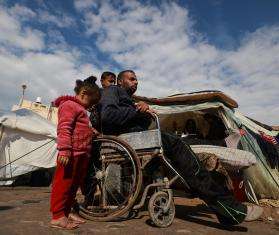Nineteen-year-old Kundyz, from Karakalpakstan, in northwestern Uzbekistan, has been on treatment for multidrug-resistant tuberculosis (MDR-TB) for more than eight months. Initially treated in a hospital, she later switched to taking her medication at home with the support of a nurse—known as directly observed treatment (DOT). Taking multiple drugs—many with unpleasant side effects—is extremely tough on people living with resistant strains of TB. Sustained support is vital in helping patients stick to the long and difficult treatment regimen.
When the COVID-19 pandemic hit Uzbekistan last March, the government imposed a strict lockdown that also disrupted DOT and other health services. With travel restrictions in place, a lack of transport options, and some health facilities closing their doors, many patients had difficulties getting to their “DOT corner”—a designated area in a local health center. Some decided not to travel for fear of contracting coronavirus. Health workers also found it challenging to visit patients in their homes to provide DOT.
Fortunately, the Doctors Without Borders/Médecins Sans Frontières (MSF) team in charge of Kundyz’s care had a solution: video directly observed treatment (VDOT). The idea had been in the planning stages for some time. But with the onset of the pandemic, MSF and the Ministry of Health decided to speed up the launch to ensure that patients could continue their TB treatment uninterrupted.
Patients on home-based treatment or living in remote areas were prioritized for the program. One of the patients chosen was Kundyz. She was given a smart phone and a data package, and was trained on how to use the platform by the MSF team. When she needed to take her daily pills, a nurse was available via the video link to provide support.
For Kundyz, this new system brought another advantage. Despite high rates of drug-resistant tuberculosis (DR-TB) in Karakalpakstan, the disease is still stigmatized. “It was always challenging for me when the DOT nurse arrived at my home,” says Kundyz. “I was worried that my neighbors would spread gossip. When I was offered VDOT, I was happy to accept it. I take my drugs early in the morning, do my household chores, and I don’t have to worry about any gossip. This mode of treatment ensures full confidentiality.”
Some patients had concerns about the new platform. “At the beginning, there was resistance towards VDOT from some patients and staff,” says MSF’s Dr. Ramanpreet Kaur. “Patients were worried about showing their face in a video due to stigma and had many concerns about privacy.”
However, after learning more about VDOT, many patients—particularly the younger ones—were keen to get involved. “After training and dissemination of information, younger patients showed an interest in VDOT, and it eventually became their preferred option,” says Dr. Kaur.
The medical staff who had initially been reluctant eventually embraced VDOT, saying it was helpful, timesaving, and effective.
MSF nurse supervisor Gulnara Elmuratova believes this method has a number of major benefits, both for patients and for health staff. “This novel treatment approach has made life easier for stigmatized patients, such as Kundyz, who do not want others to know they have TB,” she says.
Elmuratova says VDOT is also very convenient for people with busy lives and jobs, and it does not require travel costs or large numbers of health staff. “Patients on VDOT do not need to come to the DOT corner every day and lose their time. Instead, they can take their treatment under video observation. When lockdown is over, they’ll be able to go back to their jobs and continue working as before.”
The only disadvantage of VDOT, according to Kundyz, is its dependence on a reliable internet connection. “The sole issue I am experiencing is an unstable internet connection,” she says. “But I think that once this is resolved, VDOT will be the best option for many patients.”
Given MSF’s experience in Karakalpakstan, the team believes that VDOT could play an important role in ensuring treatment adherence in other places with internet access.
“Some older patients struggle with the technology and prefer the day-to-day interaction with the nurse,” says Dr. Kaur. For those patients and patients with no internet access, MSF’s team in Karakalpakstan has put in place family directly observed treatment (FDOT), where family members watch and support patients when they take their medication.
“The pandemic prompted us to initiate home care for our patients in Karakalpakstan,” says MSF deputy project coordinator Aypara Asenova. “Innovative practices such as VDOT and FDOT have played an important role in supporting patients to adhere to their treatment during the lockdown.”
MSF has been supporting the diagnosis, care, and treatment of patients with tuberculosis in Karakalpakstan, alongside the Ministry of Health, for more than 20 years.




